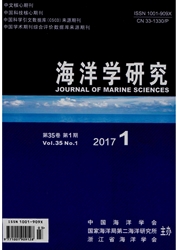

 中文摘要:
中文摘要:
依据南海低纬地区SA09—040孔高分辨率的孢粉记录,自下至上划分了4个孢粉组合带。从孢粉成分的变化,重建了22.25kaBP以来的植被与气候变化历史。结果表明:孢粉主要来源于婆罗洲和周围岛屿,孢粉1带(22.25~16.6kaBP),低山雨林植被发育,为暖热气候,从测年时间看,当时为末次冰期晚期。孢粉2带(16.6~10.82kaBP,为末次冰消期),植被以热带低山雨林和低地雨林为主,针叶的松数量较多,当时的气温比现在低。孢粉3带(全新世早期,10.82~6.43kaBP),植被以热带低山雨林和低地雨林为主,针叶松属数量减少,气温比前期升高,海平面也上升。孢粉4带(全新世中晚期,6.43kaBP至今),全新世中期为炎热、湿润的气候环境,全新世晚期可能与婆罗洲现今的植被景观相近,为热、湿的气候环境。
 英文摘要:
英文摘要:
According to the high resolution pollen record in the Core SA09-040 which was taken in the low latitude of the South China Sea, four pollen zones have been divided in ascending order. Based on the pollen composition change,the vegetation evolution and climate change since 22.25 ka B P were reconstructed. The research result shows that the pollen mainly came from the Borneo and nearby islands. In pollen zone 1(22.25 ~16.6 ka B P), the low mountain rainforest were luxuriant, the climate was warm to hot. Judged from the dating result, the age was the late stage of the Last glacial period. Pollen zone 2(16.6~10.82 ka B P, the Last deglaciation) shows that the vegetation were mainly tropical low mountain rainforest and lowland rainforest. There were many conifer pines. The temperature was lower than that of now. Pollen zone 3(the early stage of Holocene, 10.82~6.43 ka B P)shows that the vegetation were mainly tropical low mountain rainforest and lowland rainforest. The conifer pines were fewer than that in pollen zone 2, the temperature was higher than before, the sea-level rose. Pollen zone 4(the middle or late Holocene, 6.43 ka B P to now) shows that the middle stage of Holocene was hot and wet, and at the late stage of the Holoeene, the vegetation in Borneo was similar to the environment of now. The climate was hot and wet.
 同期刊论文项目
同期刊论文项目
 同项目期刊论文
同项目期刊论文
 期刊信息
期刊信息
